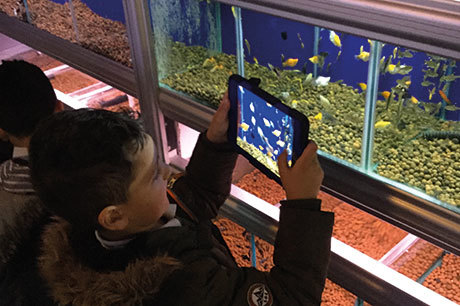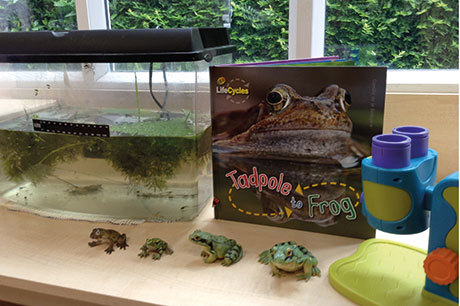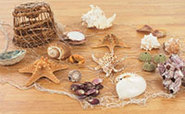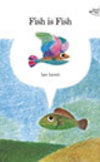
Pinky and Rainbow Fish are the names of the two fantail fish that spend their days happily floating around the fish tank at Harrington Nursery School in Derbyshire. They are happy in the company of children’s smiling faces and pointing fingers, watching them with wonder as they gracefully glide through the water. Occasionally, a sad face appears, but before long the face begins to relax as the child becomes mesmerised by the scene before them.
‘The fish are very much part of the setting – in fact, they are part of the cohort,’ explains Tom Russell, NQT. ‘The children chose them from the aquarium shop – they selected them for their differences: one is rainbow-coloured and the other one a more pinky colour – and they named them accordingly.’
HOW IT STARTED
On a visit to the Japanese Water Gardens at Bardills Garden and Aquatics Centre near Nottingham, practitioners observed that the children were fascinated with the large carp fish in the outdoor pond. They used language like, ‘It’s a shark. No, this one is huge. It’s like a whale!’, as they associated the fish with larger mammals that they had never seen before.
When the children went inside to see the aquariums, they were besotted with the colourful array of fish swimming up and down the tanks.
At the time, the nursery had tadpoles, explains Mr Russell, who collects the frog spawn from the pond in his own garden and, when introducing it, brings in a live frog to show the children what the frog spawn turns into. ‘They were fascinated with the tadpoles and enjoyed watching the changes,’ he adds. ‘So, following on from their interest in this project, coupled with the visit to the aquariums, we decided to take the children back to the garden centre where they could buy a fish tank and choose their own fish.’

UNDERSTANDING THE WORLD
The children were very excited at the thought of owning their own fish. However, they realised that they would need to choose them wisely. During a question and answer session with the staff at the garden centre, they learned that because they were getting a new tank, it would be classified as an ‘immature tank’, and therefore only certain fish would be suitable.
Mr Russell explains, ‘They asked questions like, “What type of fish do we need?” and “Would that fish be ok?”. The children are very young so even just talking to an unfamiliar adult in a new environment is an achievement, but the fact that they were all asking questions that were appropriate and relevant to the context was phenomenal.
‘They chose two fantails, which are like goldfish with big flowy tails, but they wanted them to look different. They looked at all the fish and picked out the similarities and differences before the fish were even in the same tank. This all links to understanding the world, as it’s the early learning goal for making observations about animals and change.’
Back at the setting, children were involved in setting up the aquarium so it was fit for Pinky and Rainbow Fish to live in.
‘We cleaned the tank and added the gravel,’ Mr Russell explains. ‘We then dechlorinated the water – this part was adult-led, but we talked through what was happening and why it needed to happen – and the children understood that fish can’t swim in tap water because it has chemicals in it. This led to a discussion about the differences between humans and animals. The children have taken it all on board. We can sit with them and they can have a conversation about why it all happened and why it was necessary.’

NEW-FOUND FRIENDS
The aquarium also proved soothing for a child who started at the school a week after the tank was set up. ‘If he was upset, he went there and he was mesmerised by it,’ explains Mr Russell. ‘It enabled us to build a relationship with him – we talked about what he was seeing and used basic science terminology and words like “water”, “air”, “bubbles”, “seaweed” and “filter”. We also discussed the different homes that humans and animals live in and what they need for comfort.
‘He’s now settled in really well and he still likes to watch the fish. In fact, we often find him and other children talking to the fish and saying things like, “How are you today, Rainbow Fish?” and “Where are you going today, Pinky?”.
‘Also, we’ve noticed that children are consolidating their learning and taking it to different areas of the nursery. In the water area, for example, we’ve observed children filling up empty water bottles and adding some of the small-world fish and shaking the water to create their own fish tanks.’
He adds, ‘Children use technology to further their learning. At the aquarium centre they used the iPads to take photos of the colourful fish. We then looked up their names online and projected the images onto the whiteboard.’
FISH RESOURCES 
- Set of Fish, £5.50 and Set of Divers, £25, from www.earlyexcellence.co.uk
- Large Tank, £11.99; Watering Hole, £5.89; and Small Fishing Net (6pk), £5.79, from www.cosydirect.com
- Underwater Explorer Scene Kit, £40, and Frog Figures, £12, from www.yellow-door.net
- Sea Value Box, including lobster pot, star fish and crab (pictured below, middle), £119.20, from www.reflectionsonlearning.co.uk
- Tub of Small-world Sea Creatures, 144pcs, £32.95 (pictured bottom), and Active World Tuff Tray Ocean Photographic Mat, £18.99, from www.tts-group.co.uk
BOOK CORNER 
Fish is Fish by Leo Lionni Two best friends, a baby fish and tadpole, are practically inseparable until tadpole grows legs and sets off to explore the world beyond the pond. When the tadpole, now a frog, returns to tell his friend of the amazing things he’s seen, the fish, now fully grown, tries to follow in his footsteps, but quickly finds that land is not what he expected.
The Adventures of Rainbow Fish by Marcus Pfister Enjoy five favourites in this single volume: Rainbow Fish to the Rescue!, Rainbow Fish and the Big Blue Whale, Rainbow Fish and the Sea Monster’s Cave, Rainbow Fish Finds His Way, and Rainbow Fish Discovers the Deep Sea.
This Is Not My Hat by Jon Klassen When a tiny fish shoots into view wearing a round blue top hat (which happens to fit him perfectly), trouble could be following close behind. Who’s hat is it and will the real owner ever find it? This is book two in Klassen’s hilarious and award-winning trilogy, that starts withI Want My Hat Back and ends withWe Found A Hat.
Hooray for Fish! by Lucy Cousins Swim with Little Fish and meet all his fishy friends in this rhyme of an undersea voyage. Bright, bold and hilarious.
The Pout-Pout Fish in the Big-Big Dark by Deborah Diesen and Dan Hanna Mr Fish wants to help Ms Clam find her lost pearl, but while he’s fast and smart, he’s also scared of the dark. Will he be able to help his friend?
The Fish Who Could Wish by John Bush and Korky Paul Fish’s wishes come true! He wishes for all sorts of crazy things – a castle, a car, and even fine clothes to wear – then one day he wishes to be just like all the other fish.
One Smart Fishby Christopher WormellLong ago in the deep ocean, there lived one smart fish! He wasn't the biggest and he wasn't the boldest, but he was the cleverest. What this smart fish wanted more than anything else was to walk upon the land. An award-winning insight into the theory of evolultion for young children.
Other story books
- Tiddler by Julia Donaldson
- Bright Stanley stories by Matt Buckingham
- Little Stinker by Steve Smallman
- Fidgety Fish by Ruth Galloway
- The Teeny Weeny Tadpole by Sheridan Cane and Jack Tickle
- Frog in the Bog by Helen Poole
Non-fiction
- Coral Reef: Around the clock with the animals of the ocean (Dorling Kindersley)
- Fish by Alwyne Wheeler(Usbourne Pocket Nature, Usbourne)
- Fish Facts by Geoff Swinney
- Mini Encyclopedia of the Tropical Aquarium by Gina Sandford
- Mini Encyclopedia of the Marine Aquarium by Dick Mills









